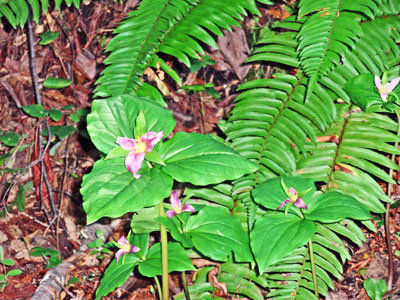
Taking a walk is always a breathtaking experience at this time of year. Witness the cobalt blue flowers nearly covering a ceanothus, or a stand of Dicentra formosa, with pink, bell-shaped flowers backlit in the spring sunlight. These are just two of our local native plants. Everywhere you look, nature is beginning the season fresh with anticipation and promise.
April 15 through 22 marks the second California Native Plant Week. Legislation in 2010, sponsored by the California Native Plant Society and introduced by Sen. Noreen Evens of Napa, assigned this week to be dedicated to appreciation, education and conservation related to California’s fabulous flora. The goal is to protect our native plant heritage and preserve it for future generations.
What exactly are native plants? According to California Native Plant Society, “native plants are those species that have evolved … with our climate, soil type and rainfall. These plants continue to co-evolve with native animal species that depend upon native plants as familiar sources of food, shelter and refuge. As water becomes a more limited resource, native plants are the choice for sustainable and ecologically sound gardening. Natives are able to flourish with minimal irrigation beyond normal rainfall and require little to no fertilizer, pesticides or maintenance.”
Visits recently to Quail Hollow Ranch County Park and Henry Cowell Redwoods State Park allowed me to see many of our California native plants in full bloom. Here are just a few of the highlights.
– Common in shady redwood forests, the western wake-robin (Trillium ovatum) is a sweet plant to look at, but don’t eat the thick, fleshy underground stems, or you’ll get quite sick.
A member of the lily-of-the-valley family, this plant was used by American Indian tribes for just that purpose, but they would also cook and eat the greens. The flower starts out white but ages to dusty pink. Trilliums get their nickname of wake-robin as they emerge even before the robins return from their winter haunts in colder parts of the country.
– I also came across the somewhat-uncommon globe lily (Calochortus albus) growing in a shaded, dry area under the oaks. Also known as fairy lanterns, these flowers are seldom seen except when they bloom. The bulbs are nutritious and were eaten by California tribes — boiled, roasted or steamed in fire pits. Dried, they could be ground into flour for later use. The globe lily is native to California and endemic to California alone.
– The silver lupine were just beginning to open in Quail Hollow, while other lupine species were in full bloom. I enjoyed the rich lilac flower spikes blooming alongside the sweet blue western hound’s tongue. Cynoglossum grande is one of the first flowers of spring and is common in mixed evergreen forests in our mountains. Small hairs on the surface of the leaf give it a rough texture, and it somewhat resembles a dog’s tongue, if you really use your imagination.
From the blossoms of both fat and slim Solomon’s seals, from the blue and white ceanothus flowers humming with bees to western bleeding heart, spring is afoot.
Take an active role in preserving the majesty of California’s native flora. Including native plants in your home landscaping can cut your water use by 60 to 90 percent over conventional gardening. California native plant gardening has a positive impact on our watersheds, habitat recovery and curbing catastrophic wildfires.
– Jan Nelson, a landscape designer and California certified nursery professional, will answer questions about gardening in the Santa Cruz Mountains. Email her at ja******@*ol.com, or visit www.jannelsonlandscapedesign.com to view past columns and pictures.











